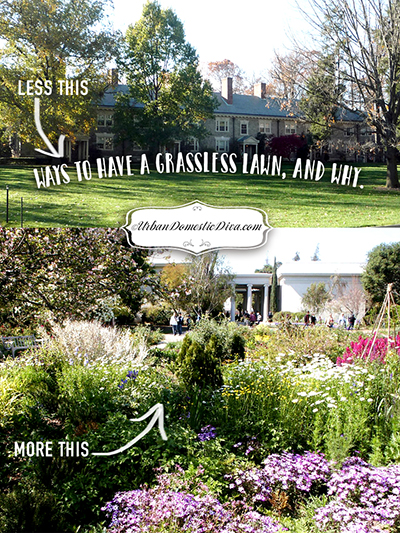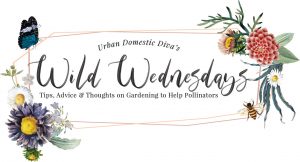
Fall is a great time to get your grass in good shape. Or get rid of it.
Ways to have a grass-free lawn, and why.
I get a lot of questions in my classes around native plant replacements for lawns. In fact, I keep getting more and more questions about it, which is really encouraging. It means people are starting to realize that their conventional- Americana-white-picket-fence-perfect-green-lawn is doing nothing for their local food web, especially the pollinators.
Now look, I have grass just like most of my neighbors. I am also married and would like to stay that way. Men and their lawns have a relationship that goes far back in our American culture. They spend time mowing it, trimming it, fertilizing it. They compete with the neighbors, share trade secrets with each other. It’s as part of their outdoor summer routine as grilling. It defines them. To understand this aspiration around a perfect lawn and our male partners’ psyche, we need to go back a little in our own history.
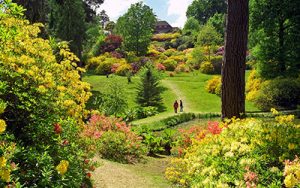
licensed under CC BY-NC-ND 2.0
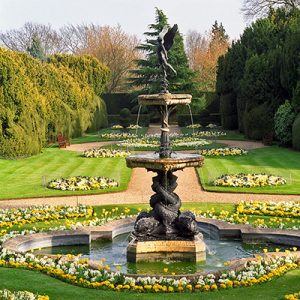
licensed under CC BY-NC-ND 2.0
Grass species were brought over from the estates of England, Ireland, and Europe. Usually, these beautiful grassy landscaped gardens were found on the big manors and castles of lords and ladies and dukes and duchesses, tended to by an army of gardeners and landscapers. Grass was a symbol of wealth and prosperity. So when our forefathers came over here they wanted to create grassy lawns and landscapes of their own. The challenge is that the climate where these grasses grow is not the same climate as we have in areas of North America. England and Ireland are cooler. with a lot of consistent moisture- a perfect combo platter for growing grass. They rarely have drought and really strong heat. This is the same reason why fall is a nice time to get your lawn green and ship-shape before winterizing it. But be warned, as in all things non-native, it takes a lot more time, effort, resources, and chemicals to keep grass green and happy in America. Usually, this does not bode well for the environment or for local insects and animals. The amount of chemicals that it takes to keep grass green and weed-free is usually very harmful to pollinators and animals. In fact, many suburban lawns have signs warning children and pets need to stay off the lawn 24 hours after a chemical treatment. If it’s that toxic for humans and pets imagine what it’s doing to your local environment, especially small insects like bees?

Grass Lawns licensed under CC BY 2.0
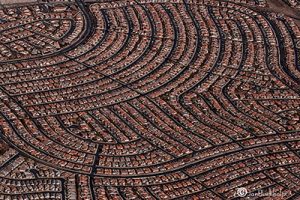
Suburban Sprawl CC BY-NC-ND 2.0
The other issue with grass is that it does not feed the local food web. Grass doesn’t play host to any pollinators, nor does it offer nectar or pollen. It doesn’t provide shelter or food for many species. Now imagine yards and yards and yards of green lawns in giant suburbs that are not offering any support to the local food webs? Those miles of grass turn into acres and acres of green wasteland. This is contributing largely to habitat loss, which housing developments don’t even realize. I would venture to say that green lawns are worse than the cement and pavement of our cities, because of the sheer amount we have planted in this country. I get it, it’s part of the American dream to have a house with 2.5 kids, a white picket fence with a nice green lawn for the children and pets to play on. It’s deep in our DNA, and it’s very hard to convince a homeowner to get rid of their lawn. But maybe we don’t have to throw the baby out with the bathwater? And if you do I have some tips to help you have a grassless lawn.
1: Take a piece of your lawn, and turn it into something else
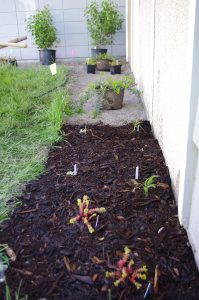
Forest Service – Northern Region licensed CC BY 2.0
You only need a few square feet of a native flower garden, or native grasses, to help bring some habitat back into your space. You and your lawn-loving hubby need to compromise on a spot in the yard to plant some native flowers and grasses, and perhaps even a big “keystone” planting. (Bio-diversity guru Doug Tallamy of Nature’s Best Hope refers to these kinds of plants as one big native anchor that can support a multitude of species, like an American oak tree, or a serviceberry bush.) This is a good compromise. I finally convinced my husband to take the sad-looking patch of lawn struggling in a mostly shaded area in front of our house and grow native grasses that prefer shade. Yes, there are a few (buy my books if you don’t believe me!). It will look a lot better than what is going on there now. Why fight nature? Sometimes you need to just embrace it and pivot.
2: There is one native grass to North America, called Buffalo Grass. Plant that instead.
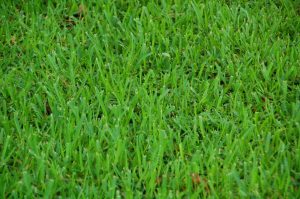
RobW_ licensed CC BY-NC-ND 2.0
Yes, we have only one native grass species to this continent, and it can grow anywhere and handle anything. But it is an expensive seed, especially if you get a ‘pure seed’ buffalo grass. Check the bag before you buy it because that will affect the price as well as the success of your grass. Buffalo grass is drought tolerant and does prefer warm soil. It doesn’t like a lot of fertilizer, being native. It is slow to germinate, so be patient. But your patience will be rewarded with a lush and hardy lawn that needs little maintenance.
3: Replace the grass with pollinator loving ground cover.
There is native ground cover options, and there are herbal ground covers that pollinators go crazy for. Here are a few good ones to consider:

sweet woodruff RobW_ licensed CC BY-NC-ND 2.0
Sweet woodruff –this ground cover has dainty flowers in the spring
and can tolerate light shade.
Creeping thyme – power pollinator and good for heavy foot traffic
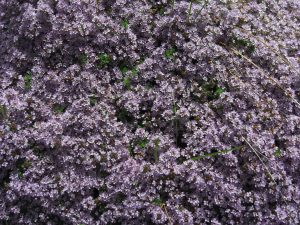
CREEPING THYME pellaea licensed CC BY 2.0
Corsican mint – not as aggressive as other mints, so it will take its time filling in
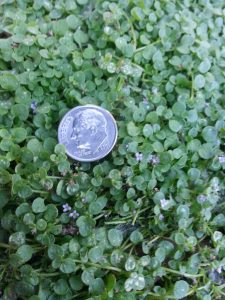
MINT ben_hengst licensed CC BY-NC-SA 2.0
Clover – yes, I know everyone wants to kill clover in their yards and it has been thought of as a weed. But clover seed used to be mixed in with hayseed for farmers in the 1900’s. It feeds the soil with nitrogen, and the pollinators (clover honey anyone?). One of the most popular lawn alternatives is white clover (Trifolium repens), also known as Dutch clover or Dutch white clover.
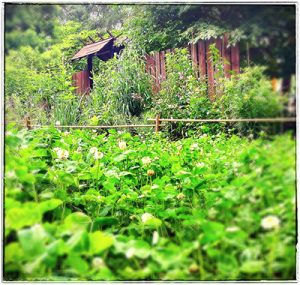
CLOVER Ronald Douglas Frazier licensed CC BY 2.0
4: Evergreen moss
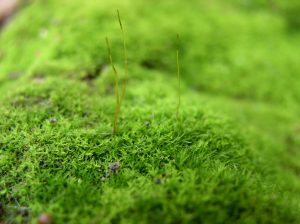
MOSS [luis] is licensed under CC BY-NC-SA 2.0
5: Try “mowable” perennial native flowers and herbs
If planned right, you can have a short, turf-like flowering carpet all season long. Some gardeners have found that with consistent mowing, the flowers train themselves to grow short and compact. Flowers like violets, chamomile, English daisies, creeping thyme, and yarrow can create an aromatic, steppable, and colorful lawn for your family-and the pollinators.
6: Try native ornamental grasses
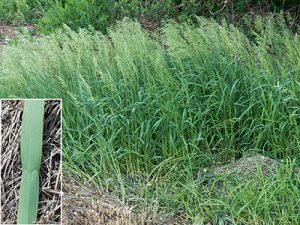
Colorado Smooth Brome Grass nature80020 licensed CC BY 2.0
Native grasses like prairie dropseed and Pennsylvania sedge are great options. The first is good in droughts and wet seasons, and the second sounds good for rain gardens. Side-oats grama is also a great option. Many native grasses play host to many moths and butterflies, supporting the greater food web. You can keep them tall and bushy, or keep them trimmed up and neat. Look at what can work in your area.
************
I am often asked, “If I choose to get rid of my lawn and try one of these approaches, how best do I get rid of my current growth in the area?” My best advice is to first, dig up and get rid of what you can. Pull everything out from the roots. Then I recommend a method called “soil solarization”, where you cover the area with plastic and hold it in place with a dirt trench along its edge. Then let the sun do the rest. The sun’s radiation cooks things under there and kills the seeds and roots left from your demolition. The sun decomposes it quickly giving the soil a hearty boost. It is best to do this method during the height of summer, for about 4-6 weeks. Then your area is ready for new plantings.
I urge you to reconsider what “American landscaping” means, and if you don’t wish to give up your lawn completely, consider a little corner just for mother nature to “do her thing”. We need to make room for her, or she will eventually kick us all out of the house.
- Sugar-Free, Low-Carb, Olive Oil Chocolate Hazelnut Tart - February 18, 2023
- Easy Slow Cooker French Onion Soup - November 28, 2022
- Recipe: Chicken Vindaloo with Whole Foods Vindaloo Curry Powder - January 22, 2022

